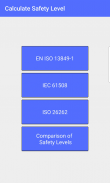




Functional Safety Risk Assessment

คำอธิบายของFunctional Safety Risk Assessment
Functional safety is a fundamental part of system and equipment engineering.
Many standards have been developed to provide concepts and methods that can be used by safety engineers. For them, the safety analisys of any application always starts from the evaluation of risk and the "target" performance which shall be fulfillled by the safety system to be designed. Safety standars usually provides simplified methods to analize hazards and risks, usually in the form of graphs or tables.
This app considers the three fundamental functional safety standards and it implements the risk graph described by each of them.
- IEC 61508: it is the core standard for functional safety. Many other standards derives from it. The output of the risk analisys is the SIL value (Safety Integrity Level)
- EN ISO 13849-1: this standard has been developed for machinery, and it is widely used in this type of application. The output of the risk analisys is the PL value (Performance Level).
- ISO 26262: common automotive safety standard. The output of the risk analisys is the ASIL value (Automotive SIL).
ความปลอดภัยในการทำงานเป็นส่วนพื้นฐานของระบบและวิศวกรรมอุปกรณ์
มาตรฐานจำนวนมากได้รับการพัฒนาเพื่อให้แนวคิดและวิธีการที่วิศวกรความปลอดภัยสามารถใช้งานได้ สำหรับพวกเขาการวิเคราะห์ความปลอดภัยของโปรแกรมประยุกต์ใด ๆ มักจะเริ่มต้นจากการประเมินความเสี่ยงและ "เป้าหมาย" ซึ่งจะต้องปฏิบัติตามระบบความปลอดภัยที่จะออกแบบ มาตรฐานความปลอดภัยมักใช้วิธีการที่เรียบง่ายในการวิเคราะห์ความเสี่ยงและความเสี่ยงโดยปกติจะอยู่ในรูปแบบของกราฟหรือตาราง
app นี้พิจารณาสามมาตรฐานความปลอดภัยพื้นฐานการทำงานและจะดำเนินการกราฟความเสี่ยงที่อธิบายโดยแต่ละของพวกเขา
- IEC 61508: เป็นมาตรฐานหลักสำหรับความปลอดภัยในการทำงาน มาตรฐานอื่น ๆ อีกมากมายมาจากข้อนี้ ผลลัพธ์ของการวิเคราะห์ความเสี่ยงคือค่า SIL (Safety Integrity Level)
- EN ISO 13849-1: มาตรฐานนี้ได้รับการพัฒนาขึ้นสำหรับเครื่องจักรและใช้กันอย่างแพร่หลายในการใช้งานประเภทนี้ ผลลัพธ์ของ analisys ความเสี่ยงคือค่า PL (ระดับประสิทธิภาพ)
- ISO 26262: มาตรฐานความปลอดภัยของรถยนต์ทั่วไป ผลลัพธ์ของ analisys ความเสี่ยงคือค่า ASIL (Automotive SIL)
























